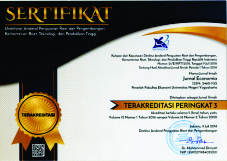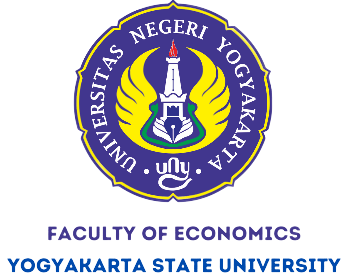Marginal Part-Time Employment in Indonesian Labor Market: Profile and Determinant
Downloads
Abstract: The increase of marginal part-time employment has been found in developed countries, as well as in developing countries. This form of non-standard employment has very short work hours (less than 15 hours/week) and no guarantee of stable employment. In Indonesia, the share of part-time worker amongst working population increased from 15.4 percent in 2009 to 22.1 percent in 2018. Unfortunately, few studies discuss about marginal part-time employment. Using binary logistic regression, this study aims to identify marginal part-time workers based on their socio-demographic characteristic. The result indicates that female (OR: 1.81; 95% CI: 1.75-1.87), living in rural area (OR: 1.12; 95% CI: 1.08-1.16), and less educated are more likely to be marginal part-timer. Therefore, it is recommended for policymakers to ensure the labor regulation adequately protect the rights of part-time worker, so that the workers condition can be improved since they are most vulnerable group in the globalized economy.
Keywords: non-standard employment, labor market, part-time, Indonesia
Pekerja Paruh Waktu Marjinal Pada Pasar Tenaga Kerja Indonesia: Profil dan Determinan
Abstrak: Peningkatan pekerja paruh waktu marjinal telah teramati pada negara-negara maju dan juga negara berkembang. Salah satu bentuk pekerjaan non-standar ini memiliki jam kerja yang sangat pendek (kurang dari 15 jam seminggu) dan tidak adanya jaminan kestabilan pekerjaan. Di Indonesia, proporsi pekerja paruh waktu diantara penduduk bekerja meningkat dari 15,4 persen pada 2009 menjadi 22,1 persen pada 2018. Sayangnya, hanya sedikit studi yang membahas tentang pekerjaan paruh waktu marjinal. Dengan menggunakan regresi logistik biner, studi ini bertujuan untuk mengidentifikasi pekerja paruh waktu marjinal berdasarkan karakteristik sosio-demografinya. Hasil menunjukkan bahwa perempuan (OR: 1,81; 95% CI: 1,75-1,87), penduduk desa (OR: 1,12; 95% CI: 1,08-1,16), dan kurang berpendidikan berisiko lebih besar menjadi pekerja paruh waktu marjinal. Oleh karena itu, direkomendasikan bagi pembuat kebijakan untuk dapat memastikan peraturan ketenagakerjaan cukup untuk melindungi hak-hak pekerja paruh waktu khusus yang termarjinal agar kondisi pekerja dapat ditingkatkan karena mereka adalah kelompok paling rentan dalam ekonomi global.
Kata kunci: pekerjaan non-standar, pasar tenaga kerja, paruh waktu, Indonesia
Downloads
AARP Public Policy Institute. (2018). Older Workers and Part-Time Employment [Fact Sheet]. Retrieved from https://www.aarp.org/content/dam/aarp/ppi/2018/part-time-older-workers.pdf
Allmendinger, J., Hipp, L., & Stuth, S. (2013). Atypical employment in Europe 1996 – 2011. Berlin: WZB Discussion Papers.
Asano, H., Ito, T., & Kawaguchi, D. (2013). Why has the fraction of nonstandard workers increased? A case study of Japan. Scottish Journal of Political Economy, 60(4), 360–389. https://doi.org/10.1111/sjpe.12015
BPS-Statistics Indonesia. (2019). Laborer situation in Indonesia August 2019 (BPS Publication No. 04130.1903). Retrieved from https://www.bps.go.id/publication/download.html
Cassidy, N., & Parsons, S. (2017). The rising share of part-time employment. RBA Bulletin, 19–26.
Champeau, M., Arsac, M., Pineau, P., & Denyset, F. (2016). Non-Standard Employment Around the World. In ILO Cataloguing in Publication Data (Vol. 44). International Labour Organization. https://doi.org/https://www.ilo.org/wcmsp5/groups/public/---dgreports/---dcomm/---publ/documents/publication/wcms_534326.pdf
Chattopadhyay, E. G. and P. (2017). Understanding Non-standard Work Arrangements: Using Research to Inform Practice. SHRM-SIOP Science of HR Series. Retrieved from http://www.siop.org/SIOP-SHRM/2017_03_SHRM-SIOP_Nonstandard_Workers.pdf
Cooke, F. L., & Jiang, Y. (2017). The growth of non-standard employment in Japan and South Korea: the role of institutional actors and impact on workers and the labour market. Asia Pacific Journal of Human Resources, 55(2), 155–176. https://doi.org/10.1111/1744-7941.12138
de Ruyter, A., & Warnecke, T. (2008). Gender, non-standard work and development regimes: A comparison of the USA and Indonesia. Journal of Industrial Relations, 50(5), 718–735. https://doi.org/10.1177/0022185608096806
Hipp, L., Bernhardt, J., & Allmendinger, J. (2015). Institutions and the prevalence of nonstandard employment. Socio-Economic Review, 13(2), 351–377. https://doi.org/10.1093/ser/mwv002
Houseman, S., & Osawa, M. (2003). Nonstandard Work in Developed Economies: Causes and Consequences. Michigan: W.E. Upjohn Institute for Employment Research. https://doi.org/10.17848/9781417505326
Irawan, P. B., Ahmed, I., & Islam, I. (2000). Labour Market Dynamics in Indonesia: Analysis of 18 Key Indicators of the Labour Market 1986-1999. In International Labour Organization. Jakarta.
Kim, H. J. (2016). Three dualization processes in Korea: The labor market, welfare policy, and political representation. Development and Society, 45(2), 297–326. https://doi.org/10.21588/dns.2016.45.2.005
Landau, I., Mahy, P., & Mitchell, R. (2015). The regulation of non-standard forms of employment in India, Indonesia and Viet Nam. (63). Retrieved from http://eprints.soas.ac.uk/20898/1/wcms_414583.pdf
Marotzke, P. (2019). The rise of part-time work: A German-French comparison (No. 20). Frankfurt: Deutsche Bundesbank.
McLaughlin, D. K., & Coleman-Jensen, A. J. (2008). Nonstandard employment in the nonmetropolitan United States. Rural Sociology, 73(4), 631–659. https://doi.org/10.1526/003601108786471558
Messenger, J. C., & Wallot, P. (2013). INWORK Policy Brief No . 7 The Diversity of " Marginal " Part-Time Employment. (7), 1–12.
Sapkal, R. S., & Sundar, K. R. S. (2017). Determinants of precarious employment in India: An empirical analysis. Precarious Work: Research in Th Sociology of Work, 31, 335–361.
Serrano, M. R., Marasigan, M. L. C., & Pupos, V. E. V. (2014). Between flexibility and security: The rise Of non-standard employment in selected ASEAN countries. Retrieved from http://library.fes.de/pdf-files/bueros/singapur/10792.pdf
Shin, K. (2013). Economic crisis, neoliberal reforms, and the rise of precarious work in South Korea. American Behavioral Scientist, 57(3), 335–353. https://doi.org/10.1177/0002764212466241















